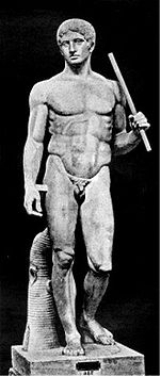
Polykleitos
Overview
Polykleitos; called the Elder, was a Greek
Ancient Greece
Ancient Greece is a civilization belonging to a period of Greek history that lasted from the Archaic period of the 8th to 6th centuries BC to the end of antiquity. Immediately following this period was the beginning of the Early Middle Ages and the Byzantine era. Included in Ancient Greece is the...
sculptor
Sculpture
Sculpture is three-dimensional artwork created by shaping or combining hard materials—typically stone such as marble—or metal, glass, or wood. Softer materials can also be used, such as clay, textiles, plastics, polymers and softer metals...
in bronze of the fifth and the early 4th century BCE. Next to Phidias
Phidias
Phidias or the great Pheidias , was a Greek sculptor, painter and architect, who lived in the 5th century BC, and is commonly regarded as one of the greatest of all sculptors of Classical Greece: Phidias' Statue of Zeus at Olympia was one of the Seven Wonders of the Ancient World...
, Myron
Myron
Myron of Eleutherae working circa 480-440 BC, was an Athenian sculptor from the mid-5th century BC. He was born in Eleutherae on the borders of Boeotia and Attica. According to Pliny's Natural History, Ageladas of Argos was his teacher....
and Kresilas
Kresilas
Kresilas was a Greek sculptor from Kydonia. He lived in the 5th century BC. He worked in Athens at the time of the Peloponnesian war, as a follower of the idealistic portraiture of Myron.-Pericles statue:...
, he is considered the most important sculptor of Classical antiquity
Classical antiquity
Classical antiquity is a broad term for a long period of cultural history centered on the Mediterranean Sea, comprising the interlocking civilizations of ancient Greece and ancient Rome, collectively known as the Greco-Roman world...
: the 4th-century catalogue attributed to Xenocrates
Xenocrates
Xenocrates of Chalcedon was a Greek philosopher, mathematician, and leader of the Platonic Academy from 339/8 to 314/3 BC. His teachings followed those of Plato, which he attempted to define more closely, often with mathematical elements...
(the "Xenocratic catalogue"), which was Pliny's guide in matters of art, ranked him between Phidias and Myron.
He was of the school of Argos
Argos
Argos is a city and a former municipality in Argolis, Peloponnese, Greece. Since the 2011 local government reform it is part of the municipality Argos-Mykines, of which it is a municipal unit. It is 11 kilometres from Nafplion, which was its historic harbour...
and a contemporary of Phidias
Phidias
Phidias or the great Pheidias , was a Greek sculptor, painter and architect, who lived in the 5th century BC, and is commonly regarded as one of the greatest of all sculptors of Classical Greece: Phidias' Statue of Zeus at Olympia was one of the Seven Wonders of the Ancient World...
(possibly also taught by Ageladas
Ageladas
Ageladas or Hagelaidas, was a celebrated Argive sculptor, who flourished in the latter part of the 6th and the early part of the 5th century BC....
).
Unanswered Questions

